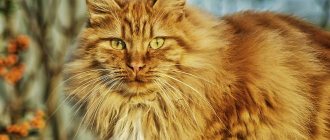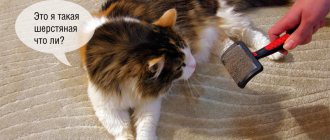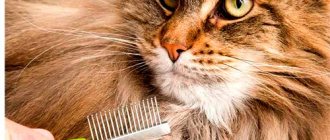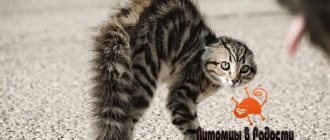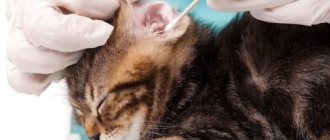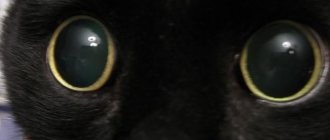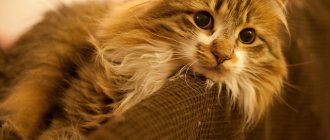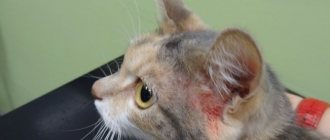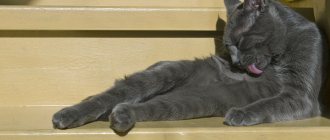All cats shed periodically. For them, this is a natural process of renewing their coat. In such cases there is no cause for concern. But sometimes the hair falls out a lot, which requires taking certain measures.
- Shedding in British breed cats
- Why does a British cat grow hair out of season?
- Prevention
- British cat sheds a lot: what to do
Why does a British cat grow hair?
Shedding in a British or Scottish kitten begins at 4 months and lasts a month. This period is called “adulting”, when the fur becomes coarser and thicker.
British cats shed twice a year, in spring and autumn. If the fur comes out in winter or summer, there is no need to panic, because the British and Scots have dense fur, and shedding does not always depend on the season. A change in coat can be caused by the following reasons:
- Allergic reaction to dry food, household chemicals, pollen from growing plants, dust, perfumes.
- Stressful situations. British cats are not stress-resistant; for them, even moving their food bowl is stressful.
- Lack of vitamins in the diet. With a lack of vitamins, the entire body suffers, the hair becomes fragile and prone to loss.
- Poor nutrition. Scots, Britons and other cat breeds should have a balanced diet.
- Childbirth. The offspring takes in a lot of nutrients; it is important to give the cat vitamins during the prenatal period.
- The presence of fungus and other skin diseases.
- Hormonal changes in the body. For example, in Scottish boys, a failure may occur due to the absence or disruption of mating phases.
- Frequent washing. You should bathe your pet only when necessary.
Health
Health problems can also cause shedding. Changes in hormonal levels can lead to hair loss. Cats shed hair after giving birth, and this is normal. But changes can also be caused by the proximity of an animal of a different sex. Even if the prospective partner lives in the next doorway, the cat can smell him. Inability to satisfy the sexual instinct or, conversely, exhaustion from frequent mating or childbirth can cause molting. Veterinarians recommend sterilizing animals not intended for breeding. This avoids hormonal surges and reduces the likelihood of tumor diseases.
Shedding can also be caused by various diseases. Severe hair loss can be an alarming symptom along with an unpleasant odor from the mouth, coughing, scratching, lethargy, etc. A veterinarian should figure out what the pet is sick with and prescribe treatment. Shedding caused by the disease will only go away after the animal has recovered.
How long does the seasonal coat change last?
This phenomenon is usually observed in animals in autumn and spring.
If a Scottish Fold or British cat sheds a lot during the season, this is normal. Shedding periods:
- Spring. A kitten or adult pet sheds its fur for the summer, and the downy undercoat goes away.
- Autumn. Scottish cats gain fluff to keep warm; in summer, indoors are cooler than outdoors.
However, if a British domestic cat did not change her fur in the spring, but did it in the summer, this is also normal, since domestic cats grow hair in different seasons, throughout the year. The shedding period ranges from 2 weeks to 2 months; if longer, you need to consult a veterinarian to find out the causative factor.
How and with what to comb long-haired cats
Table 2. Combs for cats with long hair.
| Comb model | Methods and areas of use | Note |
| Hallow Pet's side splitter (mini) | Used to remove tangles. It is a device with curved teeth-blades. | Number of teeth – 8. Handle with thumb rest. The blades are made of stainless steel. Price – 435 rub. |
| Slicker Ferplast GRO 5944 Medium | The teeth of the slicker of this model are curved at the ends. Frequently located. The tool is used only for the fluffy tail, collar area and panties. Suitable for all breeds. | The bristles of the slicker are made of steel. The set includes a comb that removes hairs from the slicker. product color – red, black. Price – 430 rub. |
| Hello Pet brush with iron teeth | Used for combing the area of the tail, collar, and pants. | Very light, does not slip on your hand. The teeth are rounded, do not scratch, are not pressed into the animal’s skin and do not fall out. The handle is made of wood. The height of the cloves is 2 cm. Price is 517 rubles. |
| Comb with teeth of various lengths Furminator Ferplast | Suitable for all types of wool. Does not damage guard hairs. Attention! For fluffies, furminators are considered the most acceptable (in terms of comfort and painlessness). | The tips are rounded at the ends. The pressure of the teeth on the cat's skin is minimal. Price – 990 rub. |
| Comb with teeth of various lengths | Used for tight, dense hairs and the same undercoat. With its help, the fur coat can be styled and fluffed. | The handle is made of plastic, the teeth are made of metal. Elegant design. Price – 480 rub. |
Combing a long-haired cat with a comb with metal teeth of various lengths
Symptoms of Unhealthy Shedding
The quality of the fur of British breed cats must always be monitored; this is very important, because cats can lose their fur not only during the season, but also due to diseases that may be caused by internal disorders in the functioning of the body. If a fold-eared cat often sheds hair from certain areas, and the process is accompanied by itching, this is a sign that the pet has a fungus (ringworm). If you experience these symptoms of unhealthy shedding, you should contact your veterinarian. Also, if there is a lack of vitamins or improper nutrition, the animal may develop dermatitis, skin irritation, which leads to hair loss. In such cases, it is worth changing the food and monitoring the cat’s reaction.
Prevention
To reduce the likelihood of severe shedding, owners need to:
- feed the animal a balanced medicinal food, to which he is definitely not allergic;
- give vitamin complexes specially selected for representatives of this breed in accordance with age characteristics;
- avoid stress, and when moving or having a baby, try to pay more attention to the cat than usual in order to make it easier to adapt to new life circumstances;
- plan mating solely on the basis of the biological cycles of the animal;
- comb regularly;
- bathe the cat no more than once every 3 months, since short-haired animals do not need frequent hygiene procedures;
- maintain constant temperature and humidity in the house.
What to do: how to reduce the amount of hair loss?
If there are signs of unhealthy shedding, there is no need to self-medicate; you need to seek help from specialists.
Sometimes cutting the animal helps solve the problem.
If a Scots sheds during the season, during this period the following rules for caring for your pet should be followed:
- brush the fur daily with a brush and massage movements;
- bathe the cat using a special shampoo;
- trim the animal to reduce the amount of hair falling out;
- ventilate your home, this helps reduce the concentration of cat hair in the air;
- provide your pet with a balanced diet enriched with vitamins;
- eliminate all possible stress factors.
By adhering to simple rules, you can significantly reduce the amount of wool throughout the apartment and on upholstered furniture, and prevent the development of an allergic reaction in the owner. You can also prevent unwanted diseases in your British cat, because when licking the cat’s fur, the cat swallows hairs that form a hairball in the stomach, causing indigestion and other internal problems.
Owners' opinion
Domestic British cats. Character, reviews:
- For many people, the waywardness of the British does not seem to be a problem. You can get used to it. If you are patient, show love and care, the cat will reciprocate;
- Many people like the ease of care associated with natural cleanliness. Still, when your corners, sofas and slippers remain intact, it’s nice.
So, according to most owners, this cat is a gift from fate. She is kind, calm, and adequate from a very early age. Fortunately, the character of any purebred British cat is quite acceptable even for a family with a small child.
Care and feeding
Your cat sheds a lot. What to do if she is healthy and calm, but her fur continues to fall off? Pay attention to the quality of shampoos and conditioners for fur coat care. Cheap, low-quality cosmetics can cause shedding. In addition, shampoos must be used according to the instructions and the concentrate must be diluted correctly. Combing not only helps to get rid of lost hair, but also improves blood circulation and nutrition of the hairs.
The cat sheds a lot. What to do? Finally, one of the most common causes of hair loss is poor diet. Cheap dry food cannot provide your furry pet with everything it needs. Choose quality products from well-known manufacturers. Natural nutrition should be balanced and the menu varied.
In conclusion, a few tips:
- comb your pet, avoiding combs with sharp teeth;
- wash your cat only with high-quality shampoo;
- use vitamin supplements during natural feeding;
- Buy special conditioners for cat fur.
Constant
Shedding, during which a British cat loses fur greatly over a long period of time (more than six months), indicates the development of pathological processes in the body. Sometimes it is associated with physical health, but much more often it indicates severe stress and other similar factors.
Important! The first thing you should pay attention to during constant shedding is the diet and living conditions of a British cat. These are the most common causes that cause excessive hair loss.
During pregnancy and lactation
The onset of shedding during pregnancy or immediately after giving birth is normal for cats. The body is rebuilt and devotes all its strength to bearing healthy offspring. During this period, British Shorthairs can shed a lot.
If hair loss continues a month after the end of the feeding period, you need to reconsider the pet’s diet and living conditions.
Sometimes the body cannot return to normal on its own, in which case you should help the cat: add vitamin complexes for the coat, switch to a high-calorie diet, organize walks in the fresh air (or at least arrange a place on the balcony). Most often, such measures are enough for the Briton to return to the normal shedding cycle.
Reducing stress levels
The most common cause of stress for a British cat is noisy company in the house and lack of privacy. The breed prefers solitude rather than constant communication.
Failure to comply with this condition leads to increased emotional stress, which can result in aggression or lead to the onset of prolonged molting.
Once the source of the irritation is eliminated, your Briton will be at peace and will return to his normal coat changing routine.
Sudden
The cause of sudden shedding of a British cat is most often diseases caused by a sudden change in diet, deterioration of living conditions and other factors.
A British cat's hair sheds a lot in the initial stages of the development of skin diseases. Most often this manifests itself at the local level and is expressed by focal lesions.
Sudden molting is always a consequence of some negative phenomena of a physical or psychological nature. As soon as the irritating factor is eliminated, the shedding of fur will immediately stop. Otherwise, the process moves to the next phase.
This is interesting: Nutrition of a 2 month old British kitten
Basic Rules
It is possible to alleviate the suffering when a British cat sheds heavily, but it is not always possible to observe all the necessary points. To avoid allergies among family and visitors to your home, regularly ventilate the room and clean it.
Special shampoos will also help you, somewhat reducing hair loss and making the process when the animal sheds less noticeable and painful.
However, there are times when the best solution would be to seek advice and help from a veterinarian. For example, if you notice hair loss only in certain places on the body of a British cat, and the hair itself falls out unevenly in clumps, immediate treatment is necessary. Often these symptoms are caused by infections of microsporia and trichophytosis, or ringworm. Such diseases are dangerous both for the pet itself and for the owners.
What to do if your British cat sheds a lot
In order to shorten the shedding period of a British cat, veterinary experts recommend using the following methods:
- Switch your pet to high-quality food and ensure your pet receives the necessary vitamins and microelements.
- In the autumn, reduce daylight hours for your pet - there is no need to leave your British cat in a lighted room in the evenings.
- Do not let the animal sleep on radiators or in other warm places. Be sure to ventilate the room at night.
- The air in the room where the cat is kept should not be dry.
In any case, such measures will help the molt proceed without complications and provide the animal with the greatest comfort.
Important! Any deviation from the norm during shedding or the formation of bald patches as a result of excessive hair shedding is a reason for an urgent visit to a specialized veterinary clinic.
Grooming
Regular brushing of fur during shedding is necessary not only to reduce soiling of carpets and sofas. This process is extremely important for the health of the British:
- during combing, the skin in the growth zone of the root bulbs is massaged;
- metabolism improves;
- the undercoat layer is ventilated.
If a cat is accustomed to brushing and does not panic at the sight of a brush, it enjoys it and its health improves.
Important! You should not bathe your British cat while shedding. This disrupts the natural balance of substances, changes the acid-base level and can prolong the period of hair loss.
Antiparasitic treatments
A mandatory procedure for British breed cats is annual vaccination and treatment against parasites (external and internal). These measures do not directly affect the molting process, but they improve health, prevent the development of a number of diseases and are always considered in conjunction with other preventive measures.
If a small British kitten sheds heavily, then first of all you need to ask whether its mother has been treated for worms, fleas and lice. Most often, at an early age, they become the cause of active shedding of fur.
Changing the indoor microclimate
The living conditions of a British cat affect how the pet sheds. In this sense, everything must be done to ensure that the animal experiences at least minimal changes in temperature and humidity, since the body is guided by the length of daylight hours and the accompanying climatic conditions.
The cat owner must:
- regularly ventilate the room;
- provide walks on the street or at least equip a place for the cat on the balcony;
- maintain an appropriate level of humidity in the house/apartment - dry air completely changes the structure of the hair and the molting cycle.
It is necessary to provide the animal with the opportunity to climb to high places and settle down there. Even within the same room, but at different levels, temperature and humidity change, and the cat itself finds the most comfortable place.
Signs of diseases
Hair loss may only be a symptom of a more serious disease. With active molting, you need to pay attention to other manifestations. Along with shedding, the following symptoms may occur that indicate illness:
- loss of interest in games, walks, if this has not previously been observed;
- refusal to eat, lack of appetite for more than a day;
- restless behavior, aggression;
- rapid breathing, rapid pulse;
- high body temperature;
- sneezing, coughing;
- vomiting and diarrhea;
- presence of blood in excrement;
- profuse tearing and salivation;
- strong and constant thirst;
- skin redness;
- frequent scratching;
- urinary incontinence;
- wheezing when breathing.
Making a diagnosis on your own will not be so easy. In addition, self-medication can be dangerous, so if such symptoms occur, you need to show your cat to a doctor. If none of the above is observed, only a lot of fur is coming out, special care, some changes in diet and environmental conditions will help.
